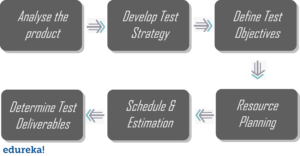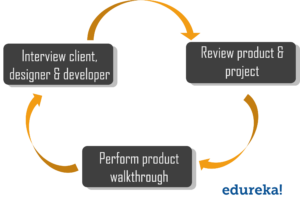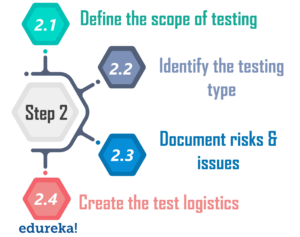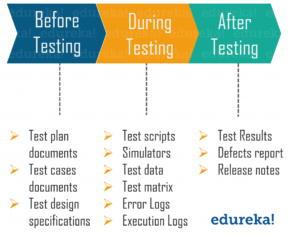Selenium Course
- 64k Enrolled Learners
- Weekend/Weekday
- Live Class
The software testing process is a crucial stage in the development of a solid and powerful application. Documentation plays a critical role in achieving effective software testing. It makes the testing process easy and organized, also saves company money and time spent on that software project. With proper documentation it is easy for the client to review the software process. In this article, we will discuss a type of software documentation, test plan in software testing.
Is Documentation Needed in Software Testing?
Yes! It is. Documentation plays a critical role in software testing. Here’s an example to convince you, people.
A company, let’s call it ‘XYZ’, delivered a project (with an unknown issue) to one of its clients. And they found the issue at the client-side, which created a very bad situation for the company. Like always all blame was on Quality Analysts(QAs).
The issue was something regarding the compatibility of one website. The issue was presented to higher authorities, they showed the client a written proof of not receiving any such requirement asking to check the compatibility of the website. So, the issue was resolved peacefully. In a way, the documented requirements saved the company from getting sued. This example shows just how important documentation really is. It can make or break a project. So, testing should be fully documented to provide efficient resource control, monitoring, and allocation. Some commonly applied documentation artifacts associated with software testing are:
Moving further with this article on ‘Test Plan in Software Testing’ let’s learn more about test plan in particular.
A test plan in software testing is a document which outlines the what, when, how, who, and more of a testing project. It contains the details of what the scope of testing is, what the test items are, who will do which testing task, what the items test/pass criteria will be, and what is needed to set up the test environment and much more.
Planning is the first step of the software testing process. A test plan document outlines the planning for the entire test process. It has the guidelines for the testing process such as approach, testing tasks, environment needs, resource requirements, schedule, and constraints. It explains the full process of what you’re going to do to put the software through its paces, in a step-by-step format. In software testing project, when you have a plan in place, chances are it will go smoother. But, why is it required to write a test plan?
Value of writing a test plan is tremendous. It offers a lot of benefits like:
Even though performing smoke testing has a lot of advantages, testers may choose not to write one, arguing, for reasons like time, challenge and redundancy constraints.
So, what happens when one doesn’t have a test plan?
So, it’s unquestionable that writing a test plan has a lot of pros than cons. Now you already know that making a test plan is the most important task of Test Management Process. So how do you write a test plan in software testing?
You can follow these 6 steps to device an efficient test plan:

Step1: Analyze the test product
It’s not possible to test a product without any information about it. So, the first step towards creating a test plan is to analyze the product, its features, and functionalities. You need to have a proper understanding of user requirements and expectations. Here are the three simple steps to get a deep understanding of the project.

Step2: Develop Test Strategy
Once you have analyzed the product, you should design a test strategy which can assist you in defining the scope of testing. Test strategy can be composed of several testing techniques. Keeping the user requirements in mind you should decide on which technique to use. For example, if you are building a website which has thousands of online users, you will include ‘Load Testing’ in your test plan. Defining a test strategy also include four more steps like shown below.

Step3: Define Objectives
The objective of any software project is to release a high-quality bug-free software product to market on time. So, as a part of a test plan, you need to clearly define the testing scope and its boundaries. You could just follow these two simple steps to define test objectives:
List all the software features which may need testing
Define the target of testing, based on features listed previously
Step4: Resource Planning
The resource plan is basically a detailed summary of all types of resources required to complete the project task. The resources here could be human, equipment and materials needed to complete a project. It is an important step which helps you determine the number of resources to be used for the project.
Step5: Develop a Schedule
With the knowledge of testing strategy and scope in hand, your next step is to develop a schedule for testing. Creating a schedule helps you control the progress of the testing process. While drawing up a schedule, you should consider factors like:
Step6: Determine Test Deliverables

Well, you can follow these simple steps to prepare a test plan. With that said, what do you actually include in the plan? Different people may come up with different sections to be included in a test plan. But who will decide what is the right format?
IEEE, an international institution that defines standards and template documents which are globally recognized. It has defined the IEEE 829 standard for system and software documentation. This IEEE 829 standard specifies the format of a set of documents that are required in each stage of the software and system testing. The table below lists out the test plan parameters according to the IEEE 829 standard test plan template.
| Parameter | Description |
| Test Plan Identifier | Uniquely identifies the test plan & may include the version number |
| Introduction | Sets objectives, scope, goals, resource & budget constraints |
| Test Items | Lists the systems and subsystems which are to be tested |
| Features to be Tested | All the features & functionalities to be tested are listed here |
| Features not to be Tested | Lists the features of the software product that need not be tested |
| Approach | Has sources of test data, inputs and outputs, testing priorities |
| Item pass/fail | Describes a success criteria for evaluating the test results |
| Suspension Criteria | Has criteria that may result in suspending testing activities |
| Test Deliverables | Includes test cases, sample data, test report, issue log |
| Testing Tasks | Describes dependencies between tasks & resources needed |
| Environmental Needs | Lists software, hardware or other testing requirements |
| Responsibilities | Lists roles and responsibilities assigned to the testing team |
| Staffing Needs | Describes the additional training needs for the staff |
| Schedule | Details on when the testing activities will take place are listed |
| Risks | Lists overall risk of the project as it pertains to testing |
| Approvals | Contains signature of approval from stakeholders |
To conclude I would say, test plan is a guidebook for the testing process and is vital to keep the entire testing process on the right track. If you have a solid plan and test plan document in place, chances are the testing process will go smoother. This brings us to the end of this article. Hope the things that you have learned here today will help you as you head out on your software testing journey.
If you found this “Test Plan in Software Testing” article relevant, check out the live-online Selenium Certification Training by Edureka, a trusted online learning company with a network of more than 250,000 satisfied learners spread across the globe.
Got a question for us? Please mention it in the comments section of this ‘Test Plan in Software Testing’ article and we will get back to you.
 Thank you for registering Join Edureka Meetup community for 100+ Free Webinars each month JOIN MEETUP GROUP
Thank you for registering Join Edureka Meetup community for 100+ Free Webinars each month JOIN MEETUP GROUPedureka.co